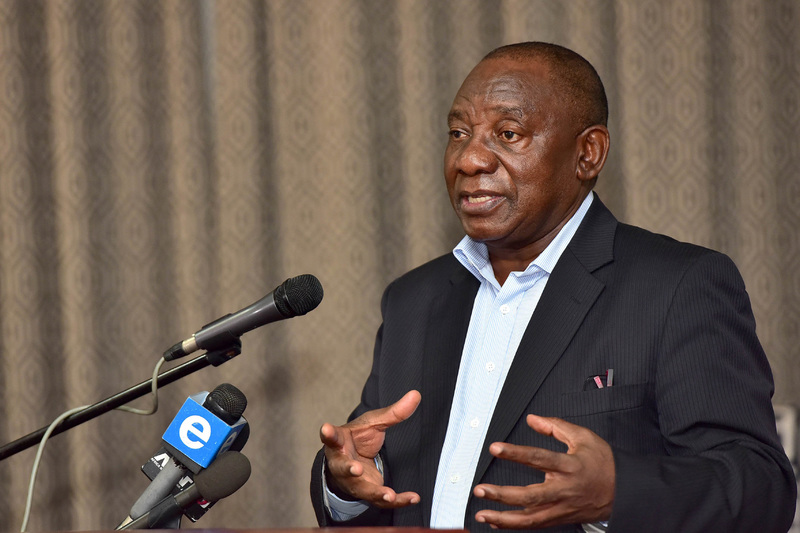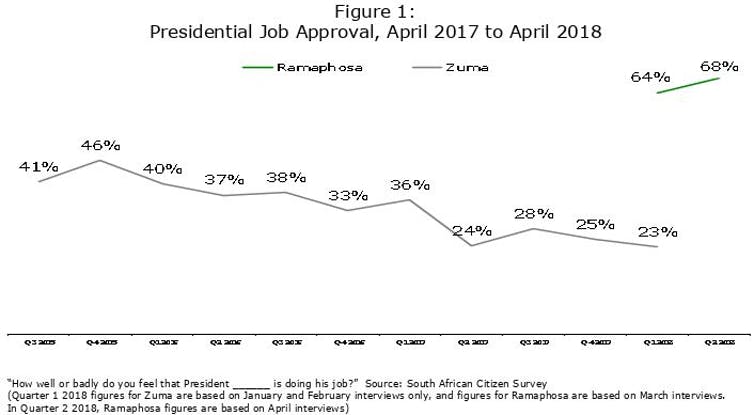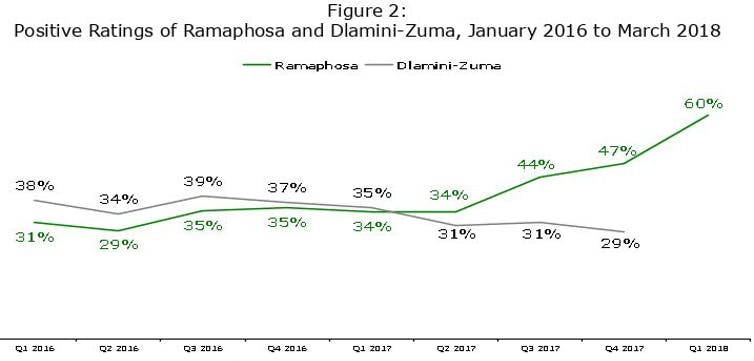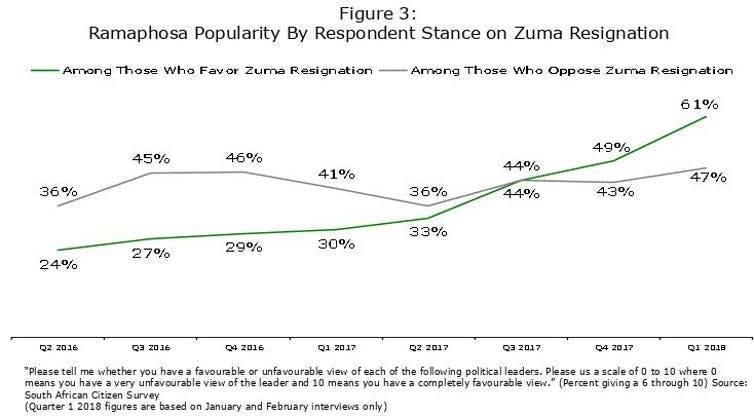Is SA’s Ramaphoria a honeymoon, or the start of true love?
13 June 2018 | Story Robert Mattes. Photo GovernmentZA. Read time 6 min.
As 2017 drew to a close South Africa’s governing party, the African National Congress (ANC), had reached the nadir of its popularity with voters. The decline was driven by public hostility towards Jacob Zuma, then president of both the party and the country.
The good ship ANC wasn’t quite sinking, but it was seriously listing. Then Cyril Ramaphosa became the party and the state’s new leader – and attention turned to whether he could steer the ANC into calmer waters.
The results of our new South African Citizens Survey fieldwork – conducted in March 2018 – suggest Ramaphosa has done well so far. Compared to the 23% of all citizens aged 18 and over who said they approved of Zuma’s performance in January and February, almost two-thirds (68%) approved of Ramaphosa’s performance.

Ramaphosa’s rise in popularity has also helped the ANC. The proportion of people who held a positive image of the party rose from 42% (in November 2017) to 68%.
Such a sharp reversal might simply be chalked up to the usual “honeymoon phenomenon historically observed by public opinion polls around the world with new presidents. Even if he’d done nothing at all, Ramaphosa stood to benefit from any comparison with his deeply unpopular predecessor.
But, far from doing nothing, Ramaphosa has acted swiftly in several areas since he took the oath of office on February 15. These surely account for a large part of the the good feelings in which he now basks.
Ramaphoria at work
The population’s elation about Ramaphosa, tagged as Ramaphoria, didn’t just begin when he inherited the mantle of high office. His popularity had already begun to rise in mid-2017 (see Figure 1) when his campaign to lead the ANC swung into high gear.
During the April to June 2017 polling period, Ramaphosa and his main competitor for party leader, Nkosazana Dlamini-Zuma, enjoyed equal levels of (un)popularity among the electorate. Their favourability ratings were just 34% and 31%, respectively.
Ramaphosa’s numbers increased to 47% during the October-December fieldwork, on the eve of the ANC National Conference in December. They kept on climbing in the new year, to 60% in the January - March 2018 survey. Importantly, positive views of Ramapahosa rose sharply across all age and racial groups, and in all nine provinces.

There are at least two different ways to explain this upward trend. One account would focus on the widely cited explanation for Ramaphosa’s ascendance to the ANC presidency. That was his ability to strike bargains with other party power brokers who then delivered their provincial delegations on the day of the key vote, making him ANC president. By extension, this logic would also presume that these power brokers were able to shift mass opinion among their respective constituencies.
But such a view would fail to explain why the largest increases in Ramaphosa’s favourability since mid-2017 occurred in the Free State and North West, two of the provinces run by members of the so-called Premier League of pro-Zuma provincial leaders.
That’s where a second account comes in. This would focus on Ramaphosa’s very conscious attempt to court public opinion directly and to reacquaint himself with average voters. Indeed, Ramaphosa’s "CR17” campaign for the party presidency was organised, well-staffed, and built around a widely publicised speaking tour that projected his image as a leader.
The change factor
Just as important was what Ramaphosa said: particularly, his decision to frame his candidacy as a departure from the “normal politics” of the ANC under Zuma. He ran as a “change” candidate committed to clean government.
He launched this arm of his campaign in April 2017 at the late South African Communist Party leader Chris Hani’s memorial lecture with a sharp attack on Zuma and the Guptas, Zuma’s friends who are accused of have captured the South African state.
Given the sourness of the public mood at that time, an attack on the sitting president was not an especially daring act. As of April 2017, 70% of South Africans surveyed said Zuma should resign his position as State President.
But it surely was an exercise in courage to make this speech in a forum of the ANC-led tripartite governing alliance – and to say it as a deputy president who could be easily fired by a president who had already sacked senior cabinet ministers.
Our data suggests that voters had been waiting for a clear signal that Ramaphosa was not a core part of the Zuma network. Voter ratings of Ramaphosa only began to move upward after that speech. Indeed, as Figure 3 shows, until that point Ramaphosa had enjoyed only slightly higher ratings among voters who wanted Zuma to stay in office, compared to those who wanted Zuma to resign.
After his speech at the Hani memorial his popularity rose sharply among the majority of South Africans who wanted Zuma to go.

Towards a lasting relationship
The Ramaphosa campaign correctly read the mood of the electorate in 2017 and strategically positioned itself accordingly. It was this crucial decision, as much as any ephemeral “honeymoon” effect, that accounts for the good feelings in which the president now basks.
 If he can maintain the focus on clean government, and show that he is committed to fixing the sins of the Zuma years, chances are that the current levels of Ramaphoria" might be more than just a brief honeymoon, but the “beginning of a beautiful relationship” with South Africans.
If he can maintain the focus on clean government, and show that he is committed to fixing the sins of the Zuma years, chances are that the current levels of Ramaphoria" might be more than just a brief honeymoon, but the “beginning of a beautiful relationship” with South Africans.
Robert Mattes, Professor in the Department of Political Studies, University of Cape Town.
 This work is licensed under a Creative Commons Attribution-NoDerivatives 4.0 International License.
This work is licensed under a Creative Commons Attribution-NoDerivatives 4.0 International License.
Please view the republishing articles page for more information.










